Caring for the young dancer (gymnast, figure skater)
Repetitive motions put athletes in these performance sports at high risk for overuse injuries. Here are the signs to look for and tests to perform. Look for disordered eating and amenorrhea, too.
Cover story
Caring for the young dancer (gymnast, figure skater)
By Jordan D. Metzl, MD
Repetitive motions put athletes in these performance sportsat high risk for overuse injuries. Here are the signs to look for and teststo perform. Look for disordered eating and amenorrhea, too.
The pediatric literature includes many articles about the medical concernsof young athletes. The medical issues of young dancers have received lessattention. Every bit as athletic as their peers who play football and soccer,young dancers--and gymnasts and figure skaters--are performance sport athletes.The types of injuries they sustain differ significantly from injuries intraditional sports, such as torn ligaments and twisted ankles. In performancesports, long practice times and intense physical activity place the athleteat risk for repetitive strain injuries. For many reasons, these injuriesare even more common during puberty than before.
Another health concern for performance sport athletes is slimness. Balletdancers, gymnasts, and figure skaters face tremendous pressure from peers,coaches, and other performers to remain extremely thin. Much of the artistryin performance sport, including leaps, spins, and aerial maneuvers, requiresa muscular and thin body. Sometimes the emphasis on thinness goes too farand creates a significant health problem. Anorexia nervosa is at least threetimes more common in ballet dancers than in the general public.1 Pediatricianswho care for young dancers (and gymnasts and figure skaters) need to knowhow to identify and manage common overuse injuries such as tendinitis, apophysitis,and stress fracture.2 Alertness to the possibility of disorderedeating and the female athlete triad of anorexia, amenorrhea, and osteoporosisalso is required. In discussing these issues I will focus on the young dancer,but the same principles apply to any performance sport athlete.
Adolescent development and risk of injury
Athletes are subject to two types of injury: macrotraumatic and microtraumatic.Macrotraumatic injuries are caused by acute traumatic events and includefractures and ligament tears. This type of injury most commonly occurs incontact sports such as football, basketball, and soccer. Microtraumaticinjuries, also known as overuse injuries, result from repetitive forcesapplied to the body when the same movement is made over and over. Sinceoveruse injuries are not traceable to one specific incident, the pediatricianneeds to take seriously any musculoskeletal complaint or focal pain in ayoung athlete, especially if the child takes part in performance sports.
Between 9 and 17 years of age, children grow and mature at a rapid rate.As they become stronger and more capable physically, teenagers are physiologicallyable to tolerate longer periods of exercise. They also are more prone toall types of injury.3 Level of sexual, skeletal, and physiologicdevelopment influences their susceptibility to overuse injuries.
Sexual development is usually assessed by using Tanner staging, whichallows estimates of skeletal maturity and hormonal status.4 Rapidperiods of growth correlate with peak levels of both growth hormone andsex-steroid hormones.
Most girls grow for about six months after their menses begin, havingreached peak height velocity at Tanner stage III; the average age of firstmenses is later in ballerinas than in their peers.5,6 Boys begintheir growth spurt at a later age than girls, both chronologically and byTanner stage, reaching peak velocity in Tanner stage IV.
Sexual maturation is accompanied by a redistribution of weight that maymake the dancer less agile and more susceptible to injury.
Skeletal development. Adolescents become stronger and lose flexibilityas they grow, which predisposes them to overuse injury. Since bone growthprecedes muscle growth, the muscles and tendons of a growing teen are constantly"stretched" (Figure 1). Tendons become easily inflamed, a conditionknown as tendinitis. Increased force on tendons can also produce apophysitis,or inflammation of the apophysis (the point where a tendon inserts in thebone).

Pediatricians should stress to young athletes the importance of maintaininggood muscle flexibility to reduce the incidence of overuse injury. A home-basedstretch program ought to work the common muscle groups, including the quadriceps,hamstrings, and the Achilles tendon, the tendon of the gastrocnemius andsoleus. Some suggested exercises appear in Table 1. The athlete should performthe stretches three times in a row, holding each stretch for 15 seconds.
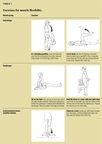
Physiologic development. Paralleling sexual and skeletal development,physiologic capability and endurance increase significantly with age. VO2Max(maximum oxygen consumption) is the most commonly used predictor of physiologicfitness. It is calculated by multiplying heart rate x stroke volume x(arterialoxygenvenous oxygen). The pediatric cardiologist or exercise physiologistperforming the test calculates oxygen utilization during exercise on anexercise bike or treadmill. VO2Max increases substantially duringadolescence, mainly because of increases in the volume and contractilityof cardiac muscle.
As children grow, oxygen availability increases, raising the capacityfor adenosine triphosphate production (ATP) from aerobic respiration. Theincrease in ATP allows muscles to contract for longer periods. This capacityenables adolescents to excercise for longer periods of time than children.Increasedendurance can lead to overly long periods of exercise and overuse injuries.
Major types of overuse injuries
Young ballerinas have more injuries after they go en pointe (Figure 2).Since male dancers do not go en pointe they have fewer injuries than theirfemale counterparts. The dance community has debated at length what theage of starting en pointe dancing should be, and most have chosen roughlyage 13, on the grounds that skeletal maturity, which girls attain aboutthat age, reduces the chance of injury. This may be a false assumption.The physical changes already discussed, the increasing intensity of balletas a child grows (see "Ballet: A way of life") and the strainon the body of dancing en pointeprobably do more than skeletal immaturityto account for the high incidence of injury after ballerinas go en pointe.
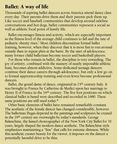

Tendinitis is the most common overuse injury in dancers. Symptoms includefocal pain in the tendon that worsens during and especially after activity.In dancers, a common site of tendinitis is the psoas tendon.
Since the stress placed on the psoas tendon increases with skeletal growth,psoas tendinitis becomes a more common problem during puberty. Repeatedleg extensions, combined with a turned-out position in the hip, stress thepsoas tendon. The dancer with psoas tendinitis complains of pain beneaththe midportion of the inguinal ligament that worsens with leg extension.The examiner should palpate the psoas tendon with the leg in this position(Figure 3).
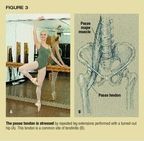
Psoas tendinitis often warrants a short course of oral anti-inflammatoriesand stretching. Stretches that actively work the psoas muscle and tendonare recommended, generally forward lunges and peri-pelvic stretching. Aphysical therapist trained in dance medicine is best suited to handle thisproblem. A local ballet company should be able to recommend someone.
The differential diagnosis of psoas tendonitis includes inguinal hernia,slipped capital femoral epiphysis, a strain of the adductor musculature,and, in rare cases, a neoplasm. If presumed tendinitis fails to improvewith treatment, obtain an X-ray to rule out bone pathology.
Apophysitis often occurs in a skeletally immature dancer. The most commonsite is the tibial tubercle, a condition known as Osgood-Schlatterdiseaseor jumper's knee. In ballet, repeated jumps stress the tibial apophysis.This is a cartilaginous structure until midway through skeletal maturation,usually age 12 in girls and age 14 in boys, after which the site ossifies.Since skeletal maturation depends not on chronological age but on developmentalstage, ossification occurs at a different time for each adolescent (Figure4).
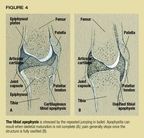
Treatment of tibial tubercle apophysitis consists primarily of stretchingthe quadriceps muscles that insert into the patella and the tibial apophysis;assuming the stretch position of a hurdler (one leg in front and one tothe side) while sitting on the floor, the patient leans backward. The stretchinglessens the force exerted on the site at rest. I often send the patientto a physical therapist who, in a single visit, can instruct her in a stretchingprogram. Icing the apophysis when the knee is painful is also very helpful.Most cases resolve completely once the adolescent reaches skeletal maturity.
Pain at an apophysis is a unique phenomenon that is not characteristicof any other condition. If pain persists and does not improve with goodstretching and icing, however, consider further evaluation beginning withan X-ray.
Stress fracture is the most serious type of overuse injury. First describedby a Prussian surgeon in 1855--40 years before the invention of the X-ray--stressfracture was defined as a painful focal point of swelling that occurredin the metatarsals of military personnel after prolonged marching.9Though today's physician has many more diagnostic tools than a physicianpracticing in the 19th century, stress fracture remains largelya clinical diagnosis.
Also known as fatigue fracture, this injury, which represents overuseof the bone, is best understood by applying the economic principals of supplyand demand. In the case described by the Prussian surgeon, the metatarsalbones supplied protection for the body, while the force of prolonged marchingrepresented the demand. When the supply of bone strength is outweighed bythe demand placed on it, bone weakens.
Stress injury and stress fracture occur along a continuum. Sometimesthe bone is stressed but does not break, resulting in a stress injury (orstress reaction), but when the injury is allowed to progress, a fractureacross the cortex can develop.
On a cellular level, bone responds to stress by producing more bone,a concept defined by Wolff's law. It takes osteoclasts seven to 10 daysto break down bone whereas bone production by osteoblasts takes three months;this disparity creates a window of vulnerability, a time when bone is proneto injury.10 As a stress injury develops, it is osteoclast breakdownthat produces a focal site of tenderness in the bone. If this stress injuryis allowed to progress, the bone will fracture. This is why early detectionis crucial.
The most common sites of stress fracture in young ballet dancers arethe foot, leg, and spine (spondylolysis). A complaint of focal bone painthat worsens with prolonged exercise warrants an evaluation for stress fracture.Since X-rays generally are normal in the early stages of stress fracture,a normal X-ray in the patient whose symptoms suggest stress fracture shouldbe followed by a bone scan or magnetic resonance imaging (MRI), dependingon the location of the injury. In making the diagnosis, the history of activity,the examination, and the X-ray, MRI, or bone scan findings must be correlated.The differential diagnosis of stress fracture includes a "true"fracture, a simple contusion, and, rarely, neoplastic disease, such as osteoblastomaor Ewing's sarcoma. Stress fracture and other overuse injuries are differentiatedfrom other conditions by pain that worsens with activity and always occurswith the activity that produces it--the more the activity the greater thepain.
The dancer pictured in Figure 5 portrays a patient with a stress fracture.This dancer complained of focal leg pain for two weeks; the pain continuedto worsen as she danced. On physical examination, she had focal bone tendernesson the anterior surface of the tibia; X-rays were normal. A bone scan showedan anterior tibial stress fracture, however. The tibia is a common siteof stress fracture in dancers because of the jumps in ballet, which repetitivelyload the bones in the lower extremities. Other possible diagnoses includemyositis of the tibialis anterior muscle or exertional compartment syndrome.

Treatment included relative rest while maintaining cardiovascular conditioningby swimming. As the dancer's symptoms abated, she gradually resumed weight-bearingactivity and began muscle strengthening. She was dancing again six weeksafter diagnosis.
The dancer portrayed in Figure 6 had a three-week history of low backpain that worsened during ballet class with back extension. The pain wasmost acute when she went into the arabesque position and was present whenshe repeated the extension in the office. Although X-rays of the lumbarspine were normal, the history and physical examination strongly suggestedspondylolysis, a stress fracture of the pars interarticularis in the lumbarspine, a common site of stress fracture in dancers.11 Singlephoton emission computed tomography (SPECT) bone scan confirmed the existenceof a stress fracture. Some practitioners like to follow up a SPECT scanwith computed tomography (CT) to show the extent of the injury. In thiscase CT revealed bilateral fractures across the pars interarticularis.

Spondylolysis merits prompt referral to an orthopedist. Treatment ofthe condition, like all stress fractures, improves with early detection.Healing occurs more readily in preadolescents than in adolescents or adults.Three months is generally the minimum time required to heal the injury thoughimprovement may take up to nine months. The bone injury is treated witha Boston brace. This is a thoracic stabilizing orthosis that limits spinalextension. It is worn under the clothes and adds little bulk. Addressingwhy the injury occurred also is important. The dancer's technique may needto be altered or her dancing be limited until the symptoms resolve. Treatmentfor spondylolysis generally should be accompanied by a physical therapyprogram that focuses on muscle strength, flexibility, and posture. In thecase illustrated, early diagnosis was followed by a period of bracing andeventual healing and a full return to ballet.
When dancers don't eat well
Nutritional status is another important consideration in the young dancer.The frequency of anorexia nervosa among ballet dancers is estimated at between3.5% and 7.6%, compared with 1.5% in the general public.12,13Anorexia athletica, a term used to describe a more subtle form of excessivethinness caused by exercise, is a less severe point along the continuumbetween normal eating and full-blown anorexia nervosa.14 Table2 lists diagnostic criteria for this condition. Anorexia primarily occursin females. As with a stress injury, early diagnosis and intervention ina patient with disordered eating and distorted body image can prevent progression.Early referral to a nutritionist is helpful.
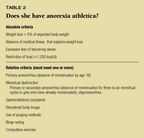
Eliciting an accurate history of disordered eating requires sensitiveand careful questioning. I have found the following questions helpful: Doyou equate thinness with success in your sport? Are you concerned that youare becoming "too thin"? Are you happy with your body? Do youknow the risks of excessive thinness?
When anorexia causes amenorrhea, the young female athlete is at highrisk for premature osteoporosis. The triad of anorexia, amenorrhea, andosteoporosis is known as the female athlete triad.
Because a stress fracture may be the first clue that an adolescent issuffering from the female athlete triad, the menstrual and dietary historyof a female athlete with a stress fracture warrants special attention. Ahistory of primary or secondary amenorrhea should prompt a comprehensiveevaluation, beginning with a dual energy X-ray absorptimetry bone-densitystudy and referral to a nutritionist, preferably one who is experiencedin working with dancers. The best way to find such an individual is to calla local ballet company for the name of a nutritionist who has worked withthe company.
Special considerations in skaters and gymnasts
Figure skating and gymnastics pose some risks for injury that are uniqueto these sports. Skaters must maintain "the axis of rotation,"an individualized sense of equilibrium that each figure skater develops.This becomes difficult when young women develop secondary sexual characteristics,which deposit fat tissue in the breasts and around the hips. Maintainingspins and achieving adequate rotation and height during jumps becomes harder,so the skater is more prone to injury. Gymnasts face a similar risk whenthe development of secondary sexual characteristics limits the sense ofbalance, particularly on the balance beam. Gymnasts also are at increasedrisk for musculoskeletal injuries as they grow because of their increasedstrength whilevaulting and somersaulting.
In an attempt to counteract these growth-related problems, skaters andgymnasts sometimes limit calories. Performance may improve temporarily whenthe adolescent loses excess fat, which encourages the athlete to continuelimiting what she eats--sometimes to a dangerous extent. Excessive dietingultimately has a negative effect on performance becauseit diminishes theathlete's strength.
Benefits outweigh the risks
Ballet, gymnastics, and figure skating are demanding sports that fosterdevelopment of personal identity and self-assuredness, important attributesfor growing children and teenagers. The pediatrician should encourage patientswith an interest in performance sports to develop their talents. With agreater understanding of the injury patterns and health concerns that arespecific to dance and other performance sports, early recognition and treatmentof injury can prevent future problems.
THE AUTHOR is Assistant Attending Physician, Division of Sports Medicine,Hospital for Special Surgery , New York, NY, and Instructor, Departmentof Pediatrics, Cornell Medical College, New York, NY. He is a member ofthe United States Olympic Committee Medical Advisory CME Board.
REFERENCES
1. Le Grange D, Tibbs J, Naokes TD: Implications of a diagnosis of anorexianervosa in a ballet school. Int J Eat Disord 1994;15:369
2. Coady CM, Micheli LJ: Stress fractures in the pediatric athlete. ClinSports Med 1997;16(2):225
3. Outerbridge AR, Micheli LJ: Overuse injuries in the young athlete.Clin Sports Med 1995;14(3):503
4. Tanner JM: Growth at adolescence, ed 2. Oxford, England, BlackwellScientific Publications, 1962
5. Brooks-Gunn J, Warren MP, Hamilton LH: The relation of eating problemsand amenorrhea in ballet dancers. Med Sci Sport Exerc 1987;19(l):41
6. Frisch RE, Wyshak G, Vincent L: Delayed menarche and amenorrhea inballet dancers. New Engl J Med 980;303:17
7. Schoenfeld-Warden N, Warden C: Pediatric obesity, an overview of etiologyand treatment. Pediatr Clin North Am 1997;44(2):339
8. Hamilton WG: Ballet, in Rieder B (ed):Sports Medicine, The SchoolAged Athlete, ed 2. Philadelphia, PA, WB Saunders, 1996
9. Breithaupt MD: Zur pathologie des menschlichen fusses. Med Zeitung1855;24:169
10.Nattiv A, Armsey TD: Stress injury to bone in the female athlete.Clin Sports Med 1997;16(2):197
11. Gerbino PG, Micheli LJ: Back injuries in the young athlete. ClinSports Med 1995;14(3):571
12.. Garner DM, GarfinkeI PE: Socio-cultural factors in the developmentof anorexia nervosa. Psychol Med 1979;9:273
13. Szmukler GI, Eisler I, Gillies C, et al: The implications of anorexianervosa in a ballet school. Psychiatry Res 1985;17:177
14. Sundot-Borgen J: Eating disorder in female athletes. Sports Med 1994;17:176
15. Yeager KK, Agostini R, Nattiv A, et al: The female athlete triad.Med Sci Sports Exerc 1993;25:775
Having "the talk" with teen patients
June 17th 2022A visit with a pediatric clinician is an ideal time to ensure that a teenager knows the correct information, has the opportunity to make certain contraceptive choices, and instill the knowledge that the pediatric office is a safe place to come for help.
Artificial intelligence improves congenital heart defect detection on prenatal ultrasounds
January 31st 2025AI-assisted software improves clinicians' detection of congenital heart defects in prenatal ultrasounds, enhancing accuracy, confidence, and speed, according to a study presented at SMFM's Annual Pregnancy Meeting.